Since early March 2020, soybean growers in the Burdekin have seen significant damage to their crops. Close inspection of crops found many with soybean stem fly damage as well as leaf spots, and stem and pod lesions. Severely affected plants have suffered complete and rapid leaf defoliation.
In many crops, plants did not collapse until the late pod-fill stage, when pods were 80-90% filled, and these crops will still give growers a substantial return. However in some crops, plants collapsed when pods were only 25-30% filled, and consequently returns to growers will be greatly reduced, not only because of lower yields but also reduced seed quality.
To date, sudden plant death has been mostly in the cultivar A6785, with no or only slight symptoms in later maturing PBR varieties Hayman and Kuranda. This may be due to A6785 being inherently more susceptible to these diseases, or because it was at a more stressful crop stage (mid to late pod-fill), than Hayman and Kuranda which were only at the pod-set or early pod-fill stages.
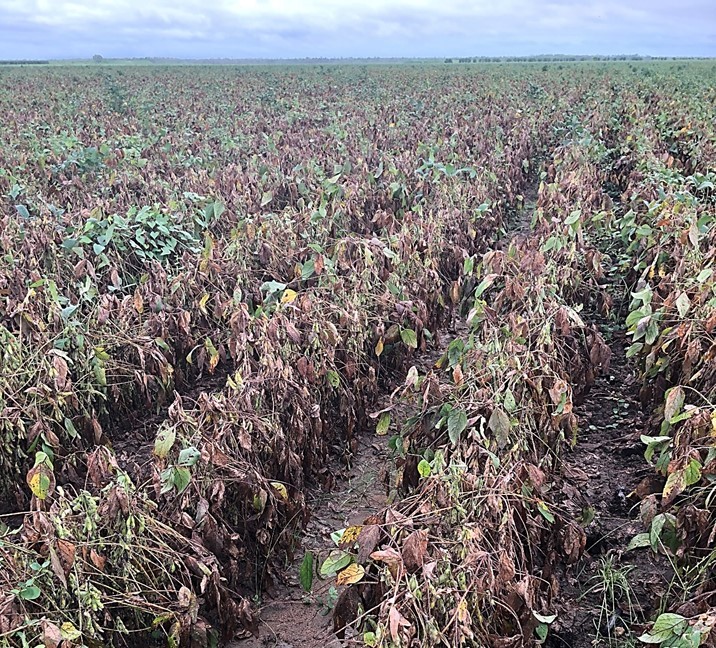
A6785 plants growing in the Burdekin affected by stem fly and plant disease in March 2020 (Photo: L. Kelly)
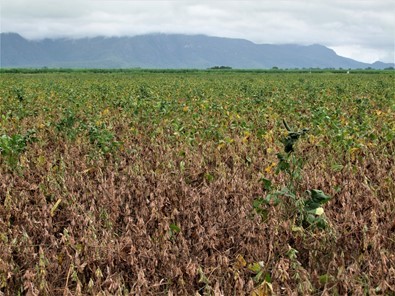
Badly diseased sector of a Burdekin soybean crop (Photo: Hugh Brier)
Recent weather conditions across northern Queensland have been conducive for the infection and spread of many fungal and bacterial pathogens. Processing of plant samples from affected sites is still underway, however the following two diseases have been detected in affected paddocks in the Burdekin.
Target spot
Corynespora cassiicola, causal agent of target spot, was detected in A6785 crops growing in the Burdekin region. Reddish-brown lesions appear in the leaves in the lower canopy and eventually spread up the plant. Leaf lesions are round to irregularly shaped and vary from small specks to larger lesions, approximately 10-15mm in diameter. A yellow halo may surround the lesions on leaves, which often develop concentric rings as they mature. Heavy infections can lead to leaf defoliation. Lesions may also be found on the petioles, stems and pods. Pod spots are typically circular and approximately 1mm in diameter, however under extended rainfall and high humidity the spots may coalesce to cover the entire pod. Symptoms can develop at all stages of plant growth.
Extended periods of rainfall, high humidity and warm temperatures are conducive for disease development. The fungus can be soil-borne and may spread in the wind, rain and in infected seed.
This pathogen has recently also been detected in crops in the Bundaberg region.
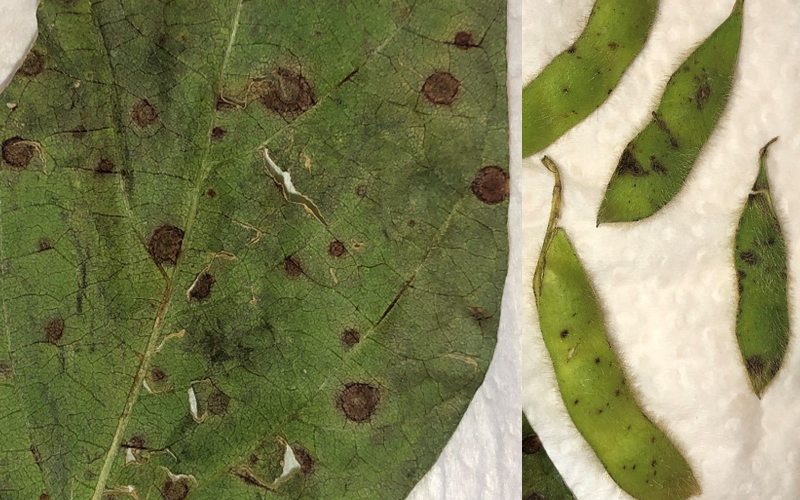
Leaf and pod lesions typical of target spot in soybean. (Photo: L. Kelly)
Anthracnose
Anthracnose in soybean, caused primarily by Colletotrichum truncatum, has been detected in affected soybean crops across the region. Soybean is susceptible to the anthracnose pathogen at all stages of growth. Foliar symptoms develop after prolonged periods of high humidity, and include necrosis of leaf laminar veins, leaf rolling, petiole cankering, and premature defoliation. Symptoms may develop on stems, petioles and pods as irregularly shaped, dark brown lesions. In advanced stages, infected tissues are covered with black fruiting bodies (acervuli) with minute black spines (setae). Symptoms are often expressed after the reproductive phases and as crops mature towards natural senesce. Affected pods may result in infected seed and will often produce fewer and smaller seed. Pre-emergence and post-emergence damping off (death of seedlings due to root or crown rot) may occur when planting infected seeds, so it is not recommended to keep planting seed from affected crops.
Petiole cankering (collapse and death of petioles), lesions on stems and pods, and the presence of fungal fruiting bodies (acervuli with setae) were frequently observed in affected plants in the Burdekin.
Similar to Target Spot, warm, wet weather favour Anthracnose development. Spores from infected plants may spread by wind and rain. Anthracnose is often a secondary pathogen that may be triggered by plant stress.
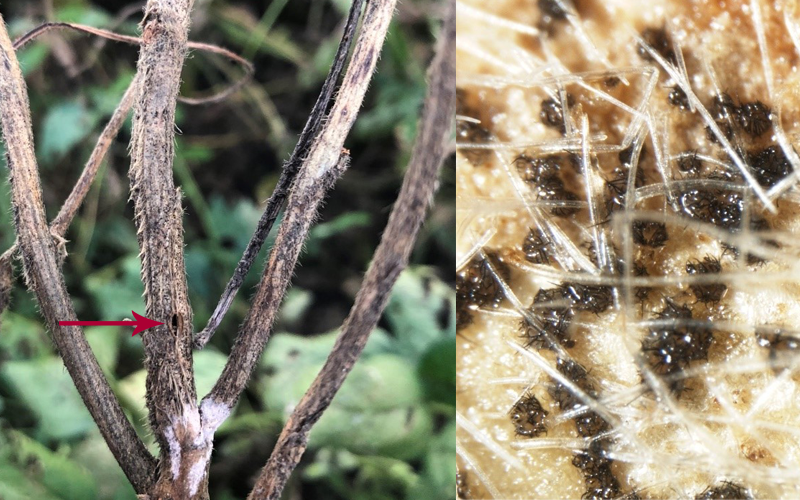
Small, black fungal bodies present on plant stems with advanced anthracnose symptoms. Exit hole (red arrow) caused by soybean stem fly also evident on many affected plants, and close up of fungal fruiting bodies (acervuli with setae). (Photos: L. Kelly)
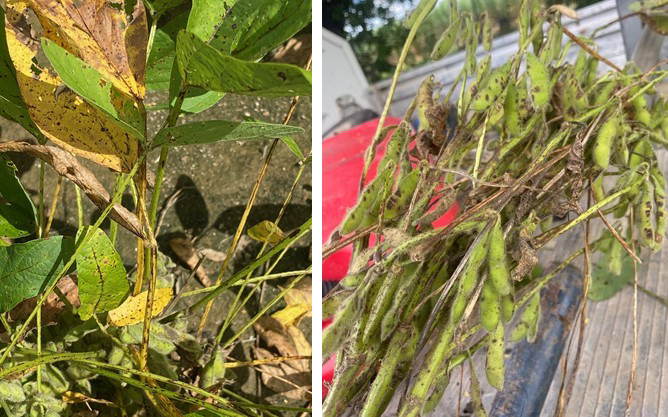
Target spot and anthracnose infected plants in Burdekin (Photos: Ian Morgan)
Soybean stem fly (Melanagromyza sojae)
Soybean stem fly populations varied considerably in badly affected A6785 crops in the Burdekin. In one block with successive A6785 plantings side by side, stem fly numbers were similar in both plantings, but the disease symptoms were far more severe in the advanced plants. Consequently, it is hard to ascertain how many of the plant deaths were due to the stem fly and how much due to disease (target spot and anthracnose).
In a major stem fly outbreak in Casino NSW in 2013, the issue was confounded by a major outbreak of charcoal rot (not the dominant disease organism in the Burdekin outbreak), with all intensities of ‘stem fly infested’ charcoal rot plants displaying similar symptoms and levels of death.
Supporting the argument that stem fly does not necessarily trigger sudden plant death was a more recent outbreak at Casino in 2018, where in cultivar A6785, despite the crop averaging 4-6 feeding tunnels and exit holes per plant, the crop matured naturally, with no premature leaf/plant deaths!
Similar target spot outbreaks and plant deaths have also been reported in A6785 in the Bundaberg region. Little stem fly activity had been reported in this region to date, but further samples will be taken to confirm the issue. Note that the sudden death symptoms have not been reported so far this season from the Mackay region.
Below are images of the fly, larvae and damage. Also included is a shot of lucerne crown borer larvae, (Zygrita diva) which also tunnels in stems, but which is a much larger insect, and which causes different damage symptoms (see past Beatsheet article on stem fly).
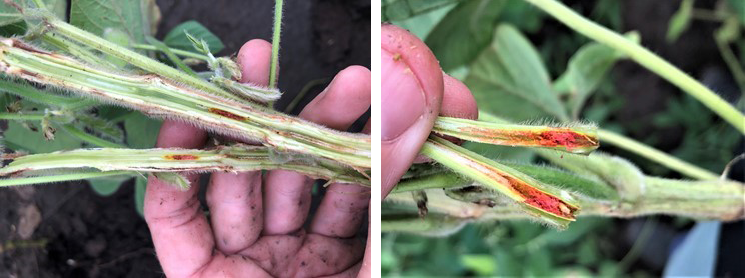
Stem fly damage to the plant pith – note the bright red discoloured pith – which can vary in colour from cream to brown to orange to red. (Photo: Nicole Carrigan Nutrien Ag Solutions, Ayr)
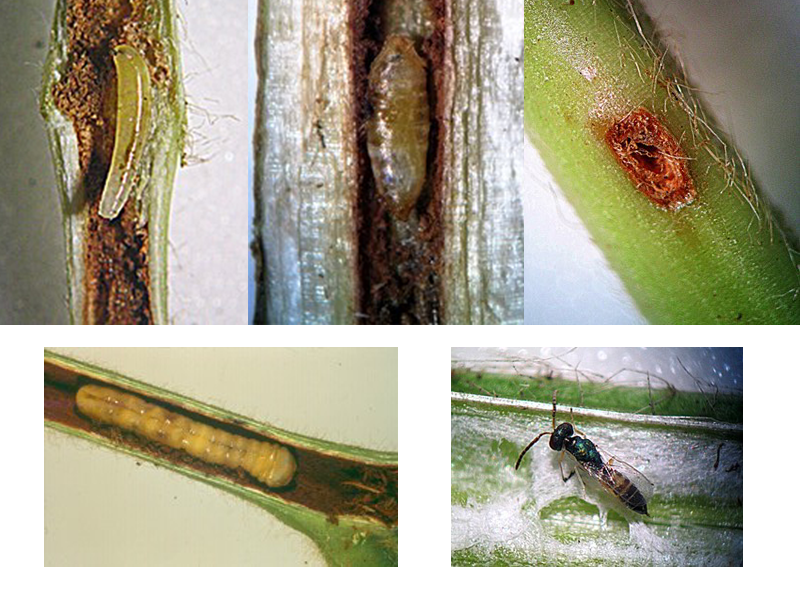
Top row: Stem fly larva (4 mm), stem fly pupa (3 mm), and exit hole made by stem fly larva before pupating. Bottom row: Crown borer larva (15 mm), and stem fly parasitoid (3mm) (Photos by Joe Wessels)
Where to from here?
The disease pathogens:
These pathogens (causal agents of target spot and anthracnose) will survive between seasons in soils, infected crop debris and seed. Growers should;
- Avoid planting soybean in or close to previously affected paddocks for at least two years
- Avoid sowing seed from affected crops
- Consider burial of crop residues
- Rotate affected areas with non-hosts, such as corn, grain sorghum or sugarcane to reduce disease inoculum
- Control weeds and volunteer soybean plants that may host the diseases
- Consider agronomic practices that avoid producing wet, humid environments (ie. planting at a lower seed rate or on wider rows to encourage air flow through the crop)
It may be that A6785 is more susceptible to these diseases, or that it had reached a more critical stress period (late pod-fill) when extremely hot and humid weather conditions favoured the disease. Planting time and varietal choice should be included in management considerations for future crops.
There are currently no fungicides registered in soybean to manage these diseases and spraying crops after they collapse will not undo the damage. Note that spraying with unregistered pesticides can render the harvested seed unmarketable and can damage the reputation of the entire Australian soybean industry. The possibility of obtaining an emergency fungicide permit is being explored.
Soybean stem fly
- To date, major stem fly outbreaks have been spasmodic. The pest is most likely present in most years in all regions, but with no noticeable plant symptoms.
- High numbers in one year does not mean they will automatically be high the next year. In the 2013 Casino outbreak, high levels of stem fly parasitism were observed and the pest was a non-event in 2014.
- Programme spraying for this pest is therefore problematic because the cheapest option (dimethoate) impacts key beneficials and repeated applications would most likely flare whitefly, mites and Helicoverpa armigera.
- Helicoverpa is developing resistance to the key caterpillar group 28 insecticide Altacor® (chlorantranipole). Inappropriate chemical choices can accelerate the increase of resistance.
The incidence of stem fly in the tropics needs further study. Some consultants are already taking observations of this pest by cutting open the stems. The trapping of adults (sticky traps) would complement these records, and might give an early warning of a bad outbreak.
Where to send disease samples?
Growers and advisers are advised to inspect crops closely for disease. If disease is suspected, then call or email Lisa Kelly (0477 747 040 | [email protected]) for advice on the best approach to collect and process samples.
This research is supported through the Grains Research and Development Corporation (GRDC) through the project Surveys and associated diagnostics of the incidence and severity of diseases of cereal and pulses within the Northern Region (DAQ1907-001RTX)
Article by Lisa Kelly and Hugh Brier.

Thanks for the excellent article. High plant population and overhead irrigation would create a favourable environment for both of these pathogens and soybean stem fly. More info and photographs of soybean stem fly is available in this GRDC Factsheet:
https://grdc.com.au/soybean-stem-fly